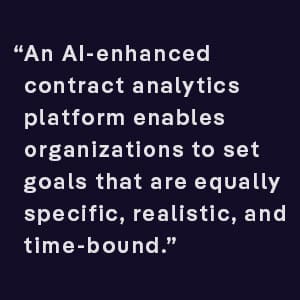Those contracts that you sign today wield a considerable amount of influence over your company’s future.
Accordingly, knowing how well your organization is meeting its contractual obligations (and how other parties are living up to theirs!) is critical to the health of the business. So is understanding how your contracting staff and processes are performing against your strategic business goals.
To do the above, though, it’s important to have powerful tools for contract performance analytics. These should provide historical, real-time, and predictive data that helps legal and other departments reduce contract liability risks; identify ways to reduce costs; increase productivity with minimal additional overhead, and quantify any improvements. After all, the road to organizational success is rarely a straight line. Senior executives need to extract reliable, actionable contract-related insights so they can understand when to stay the course (And when to pivot!).
The good news is that an AI-enhanced contract analytics platform enables you to live up to commitments and set goals that are equally specific, realistic, and time-bound. Such a CLM system also helps you track how you are executing toward those goals — and set alerts for events that prevent you from meeting overall objectives. Here’s how.
Smart Contract KPIs
The more things change, the more they stay the same. That’s certainly true in the legal industry, in which some of the most impactful contract management KPIs remain:
- Total contract value and annual contract value
- Percentage of contract value delivered or realized — versus what was agreed to
- Contract cycle times — from offering to signature
- Quantity of unsigned contracts, legal disputes, and unmet obligations
- Quality — and on-time delivery — of products and services
- Contract renewal, and churn rates and dates
- Percentage of contracts or clauses executed with non-standard terms
These KPIs should be monitored closely and reviewed regularly. The associated goals should be reset from time to time, too. Nevertheless, raw, unprocessed data can be challenging to use as the basis of important decisions. On the other hand, data visuals — like scoreboards, pie charts, and dashboards — provide an immediate understanding of how your organization is tracking against your plan.
Systems allowing users (even those without technical skills!) to drill into and distill data behind those visuals go a long way in mitigating risk, reducing costs, and demonstrating results. Custom AI-discovery reports, with natural language queries, help legal professionals identify and track all trends affecting the business. For example, your standard sell-side terms may need to be changed to make it easier for customers to do business with you. Your company may leave money on the table due to low renewal rates, poor client onboarding, or ineffective success programs. Perhaps your negotiated contract terms are creating undue risk.
Even more specifically, contract analytics engines extract these ‘decision-worthy’ insights from in-force contracts — and those that are in the pre-and post-execution phases. Their reporting tool pulls KPI data from deep within a contract repository and from any integrated applications they’re permitted to query.
Data-Driven Decision-Making
For a long time, organizations have been guided by the “gut instincts” of their leaders and influencers — when it comes to their contracts and day-to-day operations. They simply haven’t had the time or resources to understand their business — with the kind of clarity that’s now possible today.
Making decisions with the latest, most trustworthy data basically takes the personal and professional bias out of the decision-making process. According to the Harvard Business School Online, data-driven decisions:
- Require sound information gathering and interpretation
- Can be trusted for accuracy, but decision paths should be monitored and measured over time
- Motivate more proactive, efficient business management practices
- Help organizations to reduce costs and mitigate risks
- Build organizational confidence, trust — and buy-in to a new vision or strategy
What historical and real-time contract performance analytics do is provide benchmarks — with context as to how and why a business performs under particular circumstances. Predictive analytics then assess these patterns and data points and make far better recommendations based on the information that’s available in the contract file repository, ERP, CRM, and other corporate legal applications.
Ultimately, then, organizations that use a contract performance analytics solution set out on a journey of creating and monitoring success metrics; gathering data from multiple business systems and communication channels, and motivating and assessing user adoption — not to mention reviewing and realigning KPI baselines and goals altogether.
During ContractPodAi’s Educational Track session, at LegalWeek, I discussed how data-driven decision-making creates efficiencies in the legal and contracting departments. If you couldn’t attend this year’s event or missed this particular session, stay tuned for our Legalweek22 recap video!
Author:

Jerry Levine
Connect with us on Linkedin










